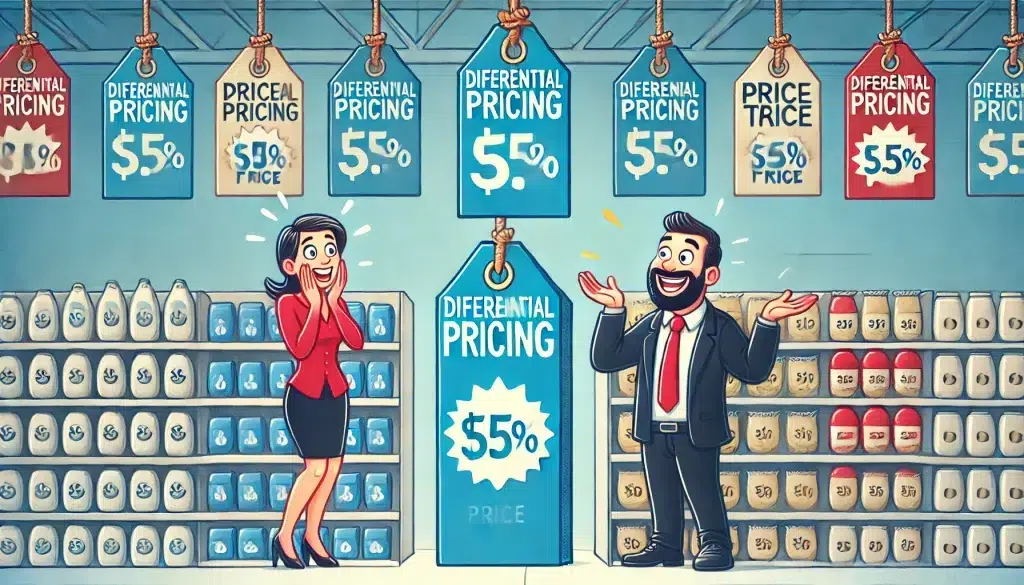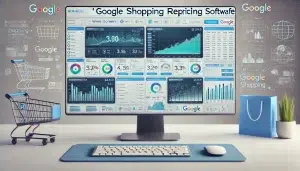
What is Differential Pricing?
Differential pricing is a strategic approach where businesses set varying prices for the same product based on specific customer characteristics. Unlike dynamic pricing, which fluctuates primarily due to market conditions, differential pricing focuses on customer demographics, purchase behavior, and location.
This strategy allows businesses to maximize profits by charging different prices to market segments, broadening their customer base, and enhancing profitability.
However, this strategy must be implemented carefully. If done poorly, it could lead to customer dissatisfaction or revenue loss. Businesses must balance price variations to attract diverse customers without alienating any particular group.
Critical Types of Differential Pricing
Differential pricing can take several forms, each designed to target specific customer segments. Let’s explore the most prevalent types:
1. Geographic Pricing
Geographic pricing is a common practice where prices vary based on the customer’s location. For instance, a product might be priced higher in urban areas with strong demand and lower in rural areas to attract more customers.
This method is particularly effective for multinational companies adapting their pricing strategies to different markets and economic conditions.
2. Differencial Pricing by Market Segments
Brands often have varying perceptions in different markets. A well-established brand in one country may be relatively unknown in another.
By adjusting prices to reflect the brand’s position in each market, businesses can better align with local expectations and improve their competitiveness.
This approach is closely related to penetration pricing, where lower prices are set in new markets to gain a foothold.
3. Product Variation Pricing
Even when selling a single product, variations in features such as size, color, or material can justify different pricing tiers.
For example, a larger-sized product may be priced higher than a smaller one, or a premium version may command a higher price than a standard model.
This strategy allows businesses to appeal to customer preferences and willingness to pay, increasing overall sales.
Differential and dynamic pricing are two distinct strategies businesses can use to optimize their pricing models. Each serves a unique purpose, and understanding their differences is critical to selecting the right approach for your business.
Differential Pricing vs. Dynamic Pricing
Differential pricing focuses on setting prices for the same product based on customer-specific factors like location, purchasing behavior, or demographic segment. The main objective is to align prices with the perceived value of various market segments, thereby maximizing revenue from each group.
This strategy is particularly effective when customer segments have varying willingness to pay, allowing businesses to capture a broader audience and increase their market share.
In contrast, dynamic pricing adjusts prices in real time according to market conditions such as supply and demand, competitor pricing, and seasonal trends. This approach is highly responsive, with prices potentially changing multiple times quickly.
It is commonly used in industries like eCommerce and travel, where market conditions can shift rapidly.
Dynamic pricing is driven more by external factors than customer characteristics, making it a flexible tool for maintaining competitiveness in volatile markets.
Key Differences Between the Strategies
When comparing these two strategies, several key differences emerge. Differential pricing is more stable, with prices typically set and reviewed periodically based on customer segmentation.
Dynamic pricing, however, involves frequent adjustments, often requiring advanced technology and real-time data analysis to manage effectively.
Businesses using dynamic pricing rely heavily on automated repricing tools to stay competitive.
In contrast, differential pricing requires a deep understanding of customer segments and careful planning to avoid potential pitfalls like customer dissatisfaction.
Pros and Cons of Differential Pricing
Pros:
Targeted Revenue Maximization: Differential pricing allows for aligning prices with different customer segments’ willingness to pay.
Broadened Market Reach: Offering multiple price points appeals to a broader audience.
Cons:
Complex Implementation: Requires detailed customer data and careful segmentation.
Risk of Customer Dissatisfaction: There’s a potential to alienate customers if they perceive pricing differences as unfair.
Pros and Cons of Dynamic Pricing
Pros:
Real-Time Responsiveness: Enables businesses to adapt to market changes quickly.
Optimized Inventory Management: Helps manage supply and demand more effectively.
Cons:
Price Volatility: Frequent price changes can confuse or frustrate customers.
Dependence on Technology: Requires sophisticated software and constant data monitoring.
How to Choose the Right Strategy for Your Business

Ultimately, the choice between differential and dynamic pricing depends on your business model, the market conditions you operate in, and the resources you have at your disposal.
Differential pricing offers a more structured approach for businesses that must tailor prices to specific customer segments.
In contrast, dynamic pricing provides the flexibility to thrive in fast-paced, competitive markets.
Real-World Applications of Differential Pricing
Differential pricing is a strategy various industries employ to maximize profits and cater to customer segments.
Here are some prominent examples of how companies successfully use differential pricing:
1. Volume Discounts
Retail giants like Costco and Sam’s Club effectively utilize differential pricing by offering volume discounts. These membership-based warehouse clubs encourage customers to buy in bulk by providing lower per-unit prices for larger quantities.
This strategy not only boosts sales but also increases customer loyalty. For instance, Costco reported a 7% increase in net sales for the fiscal year 2023, primarily driven by the success of its bulk purchasing model.
2. Seasonal Discounts
The travel and hospitality sectors frequently leverage seasonal discounts. Marriott International is a prime example of a company that adjusts its pricing based on seasonality.
During off-peak times, Marriott lowers its room rates to attract budget-conscious travelers, while rates increase significantly during peak seasons. This approach allows the company to maintain high occupancy rates year-round.
In 2022, Marriott saw a 13% increase in revenue per available room (RevPAR), driven by its dynamic pricing strategies during peak and off-peak periods.
3. Group Discounts
Group discounts are another effective use of differential pricing, particularly in the entertainment industry.
AMC Theatres, for instance, offers group discounts for movie tickets, encouraging larger groups like schools or corporate outings to choose their venues.
This strategy fills more seats and drives additional sales at concession stands. AMC reported a revenue boost of 54% in 2022, partly attributed to increased group bookings.
4. Time-Based Pricing
Another example is Uber, which uses a form of differential pricing known as “surge pricing.” During times of high demand, such as rush hour or significant events, Uber increases its ride prices.
This time-based pricing model helps balance supply and demand while maximizing revenue.
In 2023, Uber’s revenue grew by 22%,with surge pricing playing a significant role during peak usage times.
These examples illustrate how differential pricing can be adapted to various business models to enhance profitability and customer satisfaction.
By tailoring prices to specific conditions, companies like Costco, Marriott, AMC, and Uber increase their revenue and strengthen their market position.
How to Implement Differential Pricing Successfully

To implement a differential pricing strategy effectively, businesses need a deep understanding of their market segments and a clear plan for tailoring prices to meet the needs of different customer groups. Here’s a step-by-step guide to help you get started:
1. Market Segmentation: Identify Your Customer Groups
Begin by dividing your customer base into segments based on specific criteria such as demographics, purchasing behavior, and geographic location.
For example, if you’re an online retailer, you might segment customers by age, income level, or shopping habits.
Tools like Google Analytics or customer relationship management (CRM) systems can help you gather and analyze this data.
Our Tip: Use data analytics to identify patterns in customer behavior.
For instance, if you notice that a particular age group tends to purchase more during sales, you can create targeted promotions for that segment.
2. Understand Price Elasticity: Measuring Sensitivity to Price Changes
Next, determine how sensitive each customer segment is to price changes. Products with elastic demand will see significant changes in sales with price adjustments, while inelastic products will have steadier sales regardless of price shifts.
Understanding this allows you to adjust prices intelligently.
Our Tip: Conduct A/B testing with different price points for your products across customer segments. Analyze the impact on sales and use this data to fine-tune your pricing strategy.
For instance, an eCommerce store could test different prices for a product in two regions to see how each market responds.
3. Tailor Prices: Customizing Your Pricing Strategy
Once you understand your market segments and their price sensitivity, set prices that reflect the perceived value each segment places on your product, this could mean charging higher prices in areas where your brand is perceived as premium or offering discounts to price-sensitive groups.
Our Tip: Use customer data to create personalized pricing offers. For example, if your analytics show that specific customers frequently buy during promotions, you can send them targeted discounts to encourage repeat purchases. Retailers like Amazon use this approach with personalized recommendations and dynamic pricing based on browsing history.
4. Utilize Repricing Tools: Automating and Optimizing Pricing
Leverage automated repricing tools to keep your pricing competitive and responsive, especially when dealing with a large inventory or a dynamic market. These tools can monitor competitor prices, market trends, and stock levels, enabling you to adjust your prices in real-time.
Our Tip: Implement repricing software like Pricefy to continuously monitor and adjust your prices based on competitors’ actions. For example, if a competitor lowers their price on a similar product, your repricing tool can automatically change your price to remain competitive. This ensures you don’t miss out on sales due to being overpriced in a fluctuating market.
My Experience With Differential Pricing

As an e-commerce manager who has worked with multiple online stores over the years, I’ve seen firsthand the power of differential pricing in driving revenue and expanding market reach.
In one particularly successful implementation, we segmented our customer base using data from our CRM system, analyzing purchase history and browsing behavior. We then applied geographic pricing, offering slightly higher prices in affluent urban areas while providing more competitive rates in price-sensitive regions.
This strategy not only boosted our overall revenue by 15% but also helped us penetrate new markets we previously struggled to capture. However, the journey wasn’t without challenges. We had to carefully balance our pricing strategy to avoid customer backlash, especially when more tech-savvy shoppers began to notice price differences.
This experience taught me the importance of transparency and the need for a robust data analytics infrastructure to successfully implement differential pricing.
Despite the complexities, when executed thoughtfully, differential pricing has consistently proven to be a valuable tool in my e-commerce arsenal.
Wrapping Up
Differential pricing is a versatile and powerful strategy that, when executed correctly, can significantly enhance your business’s market reach and profitability. You can attract a broader audience and increase revenue by carefully analyzing customer segments and tailoring prices to match their needs and behaviors.
Remember, while differential pricing can be complex, the right tools and data can simplify the process and help you achieve your pricing goals. Consider using Pricefy’s dynamic repricing solutions to streamline your differential pricing strategy and stay competitive.




